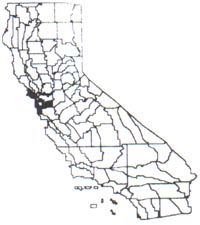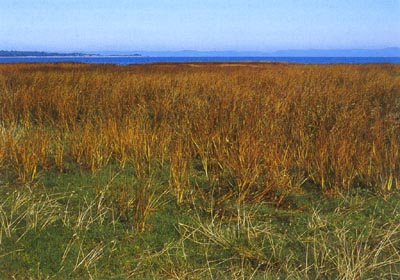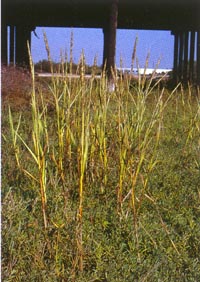Spartina alterniflora
|
|
|
|
Scientific name
|
Spartina alterniflora
|
|
Additional name information:
|
Loisel.
|
|
Common name
|
smooth cordgrass
|
|
Synonymous scientific names
|
none known
|
|
Closely related California natives
|
Spartina foliosa, S. gracilis
|
|
Closely related California non-natives:
|
3
|
|
Listed
|
CalEPPC List A-2,CDFA nl
|
|
By:
|
Chris Daehler
|
|
Distribution
|
|
|
HOW DO I RECOGNIZE IT?
Distinctive features:
|
Smooth cordgrass (Spartina
alterniflora) is a perennial, spreading grass from one foot tall in spring
to six or eight feet tall in fall. It grows naturally only in intertidal
estuarine habitats, and is often found in large, nearly monospecific stands in
coastal or bayside marshes. Its large, round stems are hollow in cross section.
Leaves are hairless, and leaf tips are sharply pointed. Young, healthy green
shoots and leaf sheaths are often streaked with red or purple just below the
sediment surface. This species is easily confused with the closely related
native California cordgrass (S. foliosa), which is usually less than
four and a half feet tall in fall and lacks red pigment in green, healthy shoot
tissues (it may have red pigment on decaying tissues). Smooth cordgrass is
highly variable in size, depending on growing conditions, and may hybridize with
native California cordgrass.
åÊ
|
|
Description:
|
|
Poaceae. Rhizomes: 1/8-1/4 in (4-7 mm) wide, fleshy,
whitish. Stems: typically 100 years (Stiller
and Denton 1995).
åÊ
|
|
|
|
WHERE WOULD I FIND IT?
|
In California smooth cordgrass currently is
found in Marin County and south San Francisco Bay, where it is rapidly spreading
across open intertidal mud flats. Smooth cordgrass also invades established salt
marsh communities, where it is likely to be found in the company of pickleweed
(Salicornia) and California cordgrass (Spartina foliosa). In
Washington smooth cordgrass is rapidly invading Willapa Bay and Puget Sound
(Padilla Bay). Smooth cordgrass may be expected in other Pacific Coast estuaries
in the future. A small patch was found in Humboldt Bay in the early 1980s, but
it has since been eradicated (Daehler and Strong 1996). Smooth cordgrass does
not grow on wave-swept Pacific Coast beaches and does not invade freshwater
marshes that lack saltwater influence.
åÊ
|
|
WHERE DID IT COME FROM AND HOW IS IT SPREAD?
|
Smooth cordgrass is native to the Atlantic
and Gulf Coast marshes of North America. It is a dominant component of Atlantic
Coast salt marshes, where it forms extensive monospecific stands (Adam 1990).
Introductions to San Francisco Bay and Padilla Bay, Washington, were associated
with salt marsh restoration and erosion control projects (Spicher and Josselyn
1985, Daehler and Strong 1996 and 1997a). The introduction in Willapa Bay,
Washington, appears to have been in association with oyster shipments during the
nineteenth century (Sayce 1988).
Vegetative fragments may break off from established plants on
eroding banks of tidal sloughs. Dredging an area infested with smooth cordgrass
can promote the spread of vegetative fragments. A viable vegetative fragment
must contain either root or rhizome material and can be transported with tides.
Seeds can float and may also be transported with tides.
åÊ
|
|
WHAT PROBLEMS DOES IT CAUSE?
|
Open intertidal mudflats are characteristic
of Pacific Coast estuaries and provide important feeding grounds for many
shorebird species (Daehler and Strong, 1996). Smooth cordgrass transforms open
intertidal habitats into monospecific stands of tall grass, reducing shorebird
feeding areas. The dense growth of smooth cordgrass also traps and holds
sediments and can clog flood control and navigation channels and alter
hydrology. The spread of smooth cordgrass threatens productive oystering grounds
in Willapa Bay, Washington. Oystering grounds in other estuaries, such as
Tomales Bay, California, would likely also be threatened if smooth cordgrass
were introduced there. Smooth cordgrass can invade and replace native California
cordgrass stands (Callaway and Josselyn 1992, Baron 1994), and the genetic
integrity of native California cordgrass is threatened by hybridization with
smooth cordgrass (Daehler and Strong, 1997b).
åÊ
|
|
HOW DOES IT GROW AND REPRODUCE?
|
Smooth cordgrass grows
most rapidly from April-September. Winter dieback of large flowering stems
begins around October, and large, dead culms are usually washed away by tides in
winter. Young, green shoots remain on most plants throughout the winter in
California. During the early stages of mudflat invasion, plants grow as
isolated, circular patches (clones). Clones spread laterally by vegetative shoots,
often three andone-thirdfeet(>1 m) per year (Callaway and Josselyn 1992). Over time,
circular patches fuse together, and mudflats are transformed into meadows of
smooth cordgrass.
Smooth cordgrass can become
reproductive as early as the first year, but more often plants first
(click on photos to view larger
image)
|
flower after two to three years.
Flowering occurs in late July-September. Copious inflorescences but few
seeds are produced in most plants (Daehler and Strong 1994). Most clones
require cross-pollination for good seed set, and cross-pollination (by
wind) is rare in isolated patches (Daehler 1996a). A few plants with high
self-fertility have consistently high seed output (Daehler 1996a). Ripe
seeds fall from inflorescences from October-January. Seeds trapped in mud
or wrack germinate in February-May. Most seedlings do not survive the
first winter because of winter storms and burial by
|
|
algae;
however, those seedlings that do survive can grow rapidly the following spring
(Daehler 1996b). Seeds remain viable for only one year, and they do not tolerate
desiccation. Vegetative fragments may be spread year round at sites prone to
erosion.
|
|
HOW CAN I GET RID OF IT?
|
1681+-+toolong+-+1681+-+toolong+-+1681+-+toolong+-+1681+-+toolong+-+
Smooth cordgrass can grow on very soft,
sometimes hip-deep mud. Some patches may be inaccessible by foot and must be
approached b
|
|
Physical control:
|
Manual/mechanical: Hand pulling is the simplest option for small
propagules (one to a few plants
Solarization: If the infestation is small (one to a few patches
1-10 m diameter), burial of the plants under geotextile fabric or a black
plastic tarp can be a means of eradication. Stems can be mowed with a weed
whacker or similar device and then covered with 100 percent shadecloth
(geotextile fabric) or heavy-duty black plastic. Covering is best begun in
spring. The area covered should exceed the plant diameter by at least one meter,
and the covering must be well anchored to the mudflat with sandbags or boards
and deep stakes. Completely covered patches may die within four months, but
mortality is assured only by waiting one year or more before removing the
cover.
Mowing: This technique has sometimes been successful in killing
smooth cordgrass outside California (Wijte and Gallagher 1992, Aberle 1993),
especially if all shoots are mown to mud level in late fall. In areas where
plants grow year round, such as California, mowing eight or more times a year
may be required to kill smooth cordgrass. Occasional mowing in spring or summer
will not kill the plants and may increase shoot density within patches (Daehler,
pers. observation).
åÊ
|
|
Biological control:
|
Biocontrol of smooth cordgrass using
host-specific insects might be possible in Willapa Bay, where plants appear to
have reduced resistance to herbivory (Daehler and Strong 1997b). However, no
control agents have been USDA approved for release in Pacific Coast estuaries.
In California biocontrol is probably not feasible because most suitable agents
would be likely to attack endemic California cordgrass as well as smooth
cordgrass.
åÊ
|
|
Chemical control:
|
Large infestations (many patches > 3 ft
or >10 m diameter) are best controlled with herbicide. Glyphosate (as Rodeoå¨)
is currently the only herbicide approved for use in estuarine wetlands, and it
must be applied by a licensed pesticide applicator. For hand spraying,
applications of 2 to 5 percent glyphosate along with a surfactant are
recommended. Surfactants that have been used with some success include X-77 and
LI-700. To maximize chances of killing smooth cordgrass, Rodeoå¨ must be applied
at low tide, when most plants are exposed to the herbicide for eight or more
hours. Rodeoå¨ may be applied by spraying or wicking. Chamberlain (1995) found
spring applications to be more effective than fall applications. Multiple
applications may be required, especially if some leaves are missed during the
first application, if exposure time is less than eight hours, if leaves are
muddy, or if plants are growing low in the intertidal zone. To date there have
been no successful eradications of large infestations of smooth cordgrass,
although attempts are in progress in Willapa Bay and San Francisco Bay (Alameda
County).
åÊ
|




